Page 72 of 604
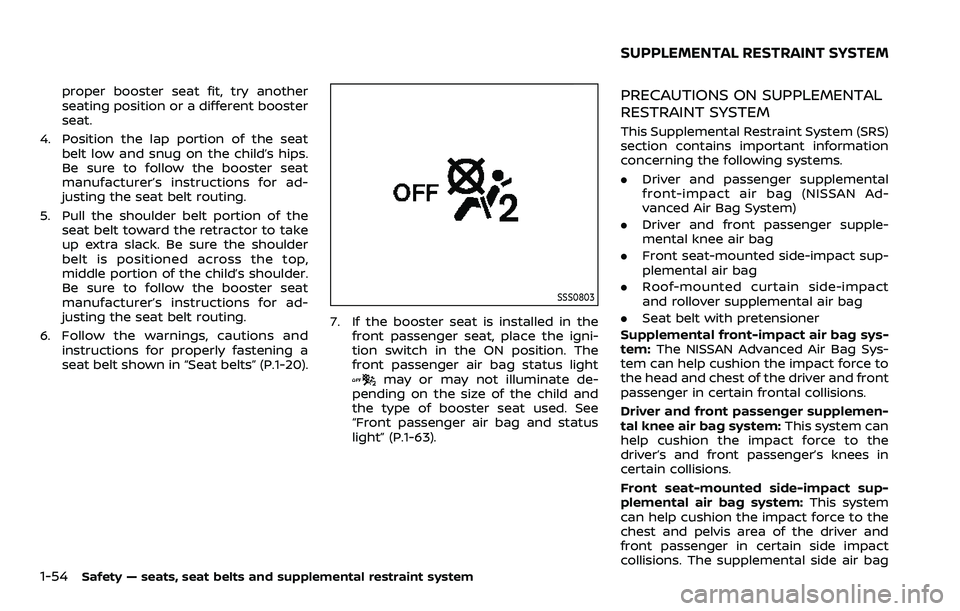
1-54Safety — seats, seat belts and supplemental restraint system
proper booster seat fit, try another
seating position or a different booster
seat.
4. Position the lap portion of the seat belt low and snug on the child’s hips.
Be sure to follow the booster seat
manufacturer’s instructions for ad-
justing the seat belt routing.
5. Pull the shoulder belt portion of the seat belt toward the retractor to take
up extra slack. Be sure the shoulder
belt is positioned across the top,
middle portion of the child’s shoulder.
Be sure to follow the booster seat
manufacturer’s instructions for ad-
justing the seat belt routing.
6. Follow the warnings, cautions and instructions for properly fastening a
seat belt shown in “Seat belts” (P.1-20).
SSS0803
7. If the booster seat is installed in thefront passenger seat, place the igni-
tion switch in the ON position. The
front passenger air bag status light
may or may not illuminate de-
pending on the size of the child and
the type of booster seat used. See
“Front passenger air bag and status
light” (P.1-63).
PRECAUTIONS ON SUPPLEMENTAL
RESTRAINT SYSTEM
This Supplemental Restraint System (SRS)
section contains important information
concerning the following systems.
. Driver and passenger supplemental
front-impact air bag (NISSAN Ad-
vanced Air Bag System)
. Driver and front passenger supple-
mental knee air bag
. Front seat-mounted side-impact sup-
plemental air bag
. Roof-mounted curtain side-impact
and rollover supplemental air bag
. Seat belt with pretensioner
Supplemental front-impact air bag sys-
tem: The NISSAN Advanced Air Bag Sys-
tem can help cushion the impact force to
the head and chest of the driver and front
passenger in certain frontal collisions.
Driver and front passenger supplemen-
tal knee air bag system: This system can
help cushion the impact force to the
driver’s and front passenger’s knees in
certain collisions.
Front seat-mounted side-impact sup-
plemental air bag system: This system
can help cushion the impact force to the
chest and pelvis area of the driver and
front passenger in certain side impact
collisions. The supplemental side air bag
SUPPLEMENTAL RESTRAINT SYSTEM
Page 73 of 604
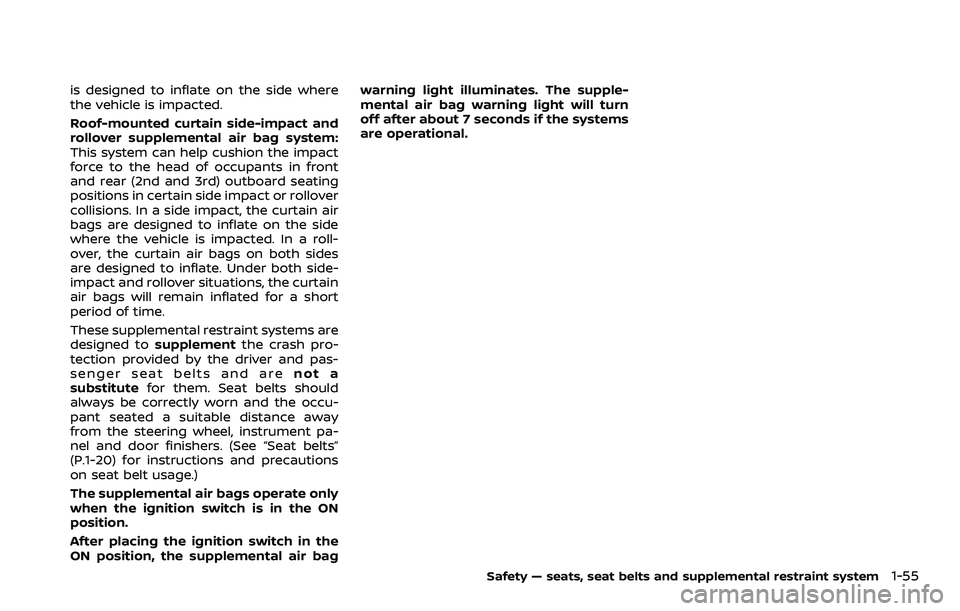
is designed to inflate on the side where
the vehicle is impacted.
Roof-mounted curtain side-impact and
rollover supplemental air bag system:
This system can help cushion the impact
force to the head of occupants in front
and rear (2nd and 3rd) outboard seating
positions in certain side impact or rollover
collisions. In a side impact, the curtain air
bags are designed to inflate on the side
where the vehicle is impacted. In a roll-
over, the curtain air bags on both sides
are designed to inflate. Under both side-
impact and rollover situations, the curtain
air bags will remain inflated for a short
period of time.
These supplemental restraint systems are
designed tosupplement the crash pro-
tection provided by the driver and pas-
senger seat belts and are not a
substitute for them. Seat belts should
always be correctly worn and the occu-
pant seated a suitable distance away
from the steering wheel, instrument pa-
nel and door finishers. (See “Seat belts”
(P.1-20) for instructions and precautions
on seat belt usage.)
The supplemental air bags operate only
when the ignition switch is in the ON
position.
After placing the ignition switch in the
ON position, the supplemental air bag warning light illuminates. The supple-
mental air bag warning light will turn
off after about 7 seconds if the systems
are operational.
Safety — seats, seat belts and supplemental restraint system1-55
Page 74 of 604
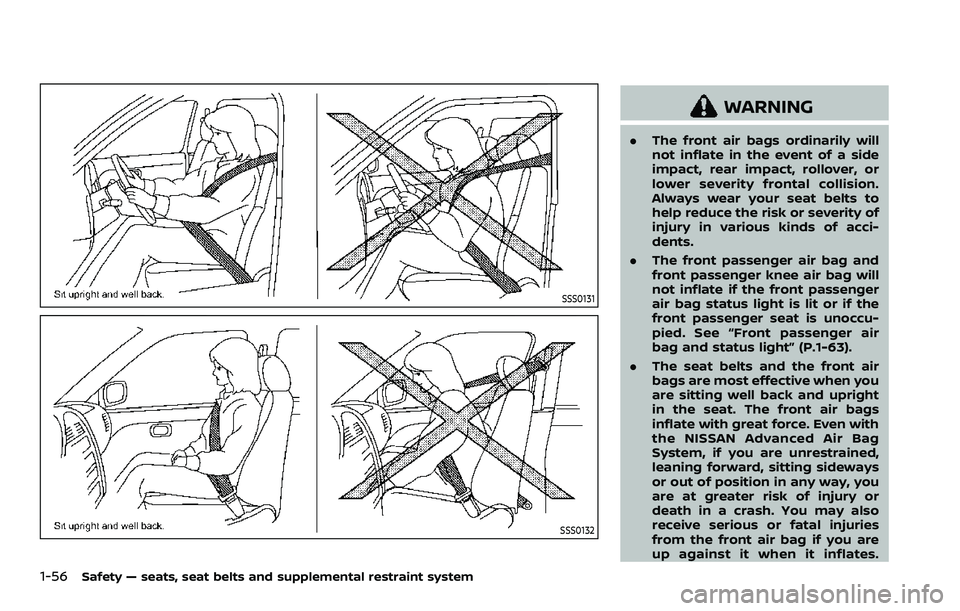
1-56Safety — seats, seat belts and supplemental restraint system
SSS0131
SSS0132
WARNING
.The front air bags ordinarily will
not inflate in the event of a side
impact, rear impact, rollover, or
lower severity frontal collision.
Always wear your seat belts to
help reduce the risk or severity of
injury in various kinds of acci-
dents.
. The front passenger air bag and
front passenger knee air bag will
not inflate if the front passenger
air bag status light is lit or if the
front passenger seat is unoccu-
pied. See “Front passenger air
bag and status light” (P.1-63).
. The seat belts and the front air
bags are most effective when you
are sitting well back and upright
in the seat. The front air bags
inflate with great force. Even with
the NISSAN Advanced Air Bag
System, if you are unrestrained,
leaning forward, sitting sideways
or out of position in any way, you
are at greater risk of injury or
death in a crash. You may also
receive serious or fatal injuries
from the front air bag if you are
up against it when it inflates.
Page 75 of 604

Always sit back against the seat-
back and as far-away as practical
from the steering wheel or instru-
ment panel. Always use the seat
belts.
. The driver and front passenger
seat belt buckles are equipped
with sensors that detect if the
seat belts are fastened. The Ad-
vanced Air Bag System monitors
the severity of a collision and seat
belt usage then inflates the air
bags. Failure to properly wear
seat belts can increase the risk
or severity of injury in an acci-
dent.
. The front passenger seat is
equipped with occupant classifi-
cation sensors (weight sensors)
that turn the front passenger air
bag and front passenger knee air
bag OFF under some conditions.
These sensors are only used in
this seat. Failure to be properly
seated and wearing the seat belt
can increase the risk or severity
of injury in an accident. See
“Front passenger air bag and
status light” (P.1-63).
. Keep hands on the outside of the
steering wheel. Placing them in-
side the steering wheel rim could increase the risk of injury if the
front air bag inflates.
SSS0007
SSS0006
Safety — seats, seat belts and supplemental restraint system1-57
Page 76 of 604
1-58Safety — seats, seat belts and supplemental restraint system
SSS0008
SSS0009
SSS0099
SSS0100
WARNING
.Never let children ride unrest-
rained or extend their hands or
face out of the window. Do not
attempt to hold them in your lap
or arms. Some examples of dan-
gerous riding positions are
shown in the illustrations.
. Children may be severely injured
or killed when the front air bags,
side air bags or curtain air bags
inflate if they are not properly
restrained. Pre-teens and chil-
dren should be properly re-
strained in the rear seat, if
possible.
. Even with the NISSAN Advanced
Air Bag System, never install a
rear-facing child restraint in the
front seat. An inflating front air
bag could seriously injure or kill
your child. See “Child restraints”
(P.1-32) for details.
Page 77 of 604
SSS0832
SSS0833
SSS0140
SSS0162
SSS0159
WARNING
Front seat-mounted side-impact
supplemental air bags and roof-
mounted curtain side-impact and
rollover supplemental air bags:
.The side air bags ordinarily will
not inflate in the event of a front
impact, rear impact, rollover, or
lower severity side collision. Al-
ways wear your seat belts to help
reduce the risk or severity of
injury in various kinds of acci-
dents.
Safety — seats, seat belts and supplemental restraint system1-59
Page 78 of 604
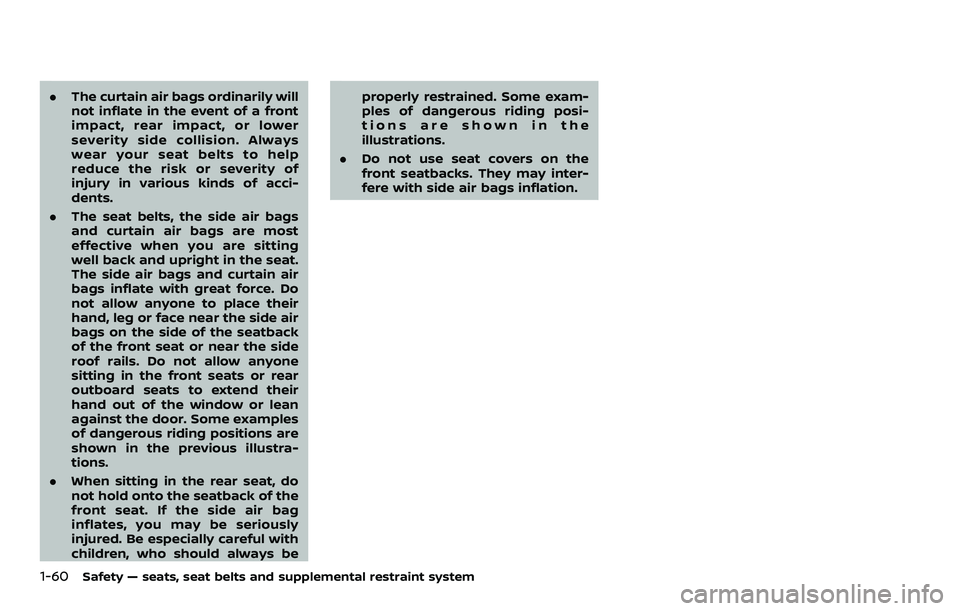
1-60Safety — seats, seat belts and supplemental restraint system
.The curtain air bags ordinarily will
not inflate in the event of a front
impact, rear impact, or lower
severity side collision. Always
wear your seat belts to help
reduce the risk or severity of
injury in various kinds of acci-
dents.
. The seat belts, the side air bags
and curtain air bags are most
effective when you are sitting
well back and upright in the seat.
The side air bags and curtain air
bags inflate with great force. Do
not allow anyone to place their
hand, leg or face near the side air
bags on the side of the seatback
of the front seat or near the side
roof rails. Do not allow anyone
sitting in the front seats or rear
outboard seats to extend their
hand out of the window or lean
against the door. Some examples
of dangerous riding positions are
shown in the previous illustra-
tions.
. When sitting in the rear seat, do
not hold onto the seatback of the
front seat. If the side air bag
inflates, you may be seriously
injured. Be especially careful with
children, who should always be properly restrained. Some exam-
ples of dangerous riding posi-
tions are shown in the
illustrations.
. Do not use seat covers on the
front seatbacks. They may inter-
fere with side air bags inflation.
Page 79 of 604
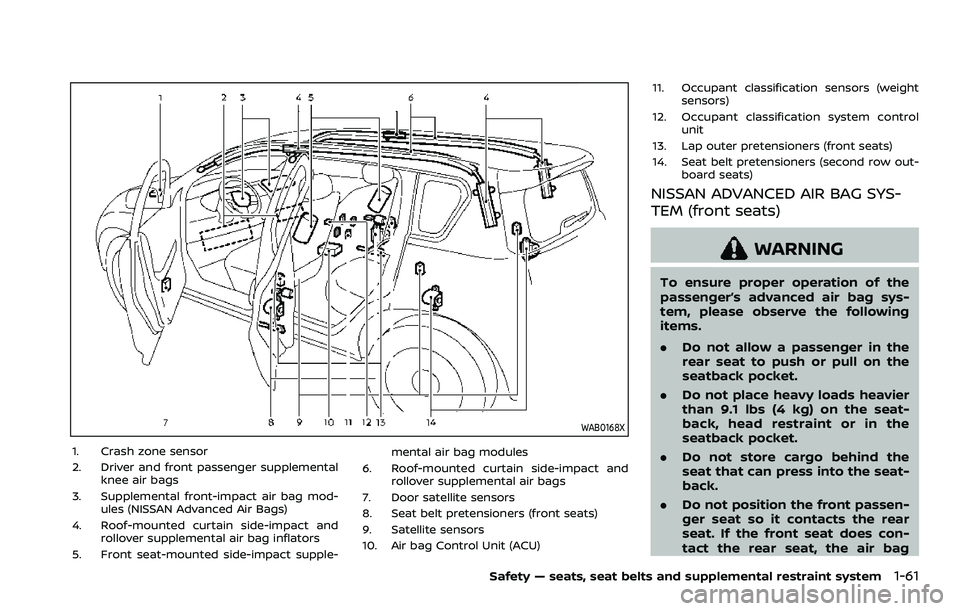
WAB0168X
1. Crash zone sensor
2. Driver and front passenger supplementalknee air bags
3. Supplemental front-impact air bag mod- ules (NISSAN Advanced Air Bags)
4. Roof-mounted curtain side-impact and rollover supplemental air bag inflators
5. Front seat-mounted side-impact supple- mental air bag modules
6. Roof-mounted curtain side-impact and rollover supplemental air bags
7. Door satellite sensors
8. Seat belt pretensioners (front seats)
9. Satellite sensors
10. Air bag Control Unit (ACU) 11. Occupant classification sensors (weight
sensors)
12. Occupant classification system control unit
13. Lap outer pretensioners (front seats)
14. Seat belt pretensioners (second row out- board seats)
NISSAN ADVANCED AIR BAG SYS-
TEM (front seats)
WARNING
To ensure proper operation of the
passenger’s advanced air bag sys-
tem, please observe the following
items.
.Do not allow a passenger in the
rear seat to push or pull on the
seatback pocket.
. Do not place heavy loads heavier
than 9.1 lbs (4 kg) on the seat-
back, head restraint or in the
seatback pocket.
. Do not store cargo behind the
seat that can press into the seat-
back.
. Do not position the front passen-
ger seat so it contacts the rear
seat. If the front seat does con-
tact the rear seat, the air bag
Safety — seats, seat belts and supplemental restraint system1-61